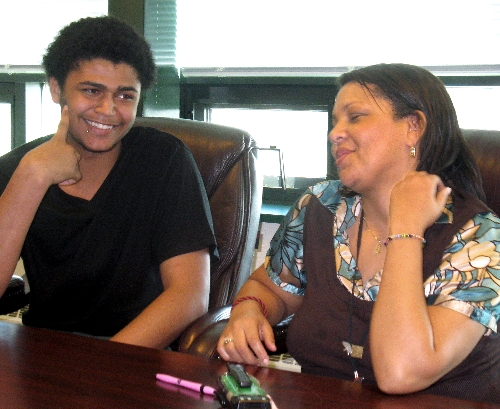Report: Nevada stands out for low graduation rate

HAGERSTOWN, Md. — The last straw for 17-year-old Alton Burke was a note left on his door. The high school dropout picked up the phone and re-enrolled at South Hagerstown High.
Burke missed roughly 200 days of class, but Heather Dixon, the student intervention specialist who left the note, never gave up on him.
Aggressive efforts to prevent students such as Burke from dropping out contributed to a modest 3.5 percentage point increase nationally in the high school graduation rate from 2001 to 2009, according to research to be presented today at the Grad Nation summit in Washington. The event was organized by the children’s advocacy group America’s Promise Alliance founded by former Secretary of State Colin Powell.
The graduation rate was 75 percent in 2009, meaning 1 in 4 students fails to get a diploma in four years, researchers found. That’s well below the organization’s goal of 90 percent by 2020.
Researchers found that the number of “dropout factories,” schools that fail to graduate more than 60 percent of students on time, had dropped by more than 450 between 2002 and 2010, but that 1,550 remain.
“Big gains are possible if you work hard at it, and if you don’t focus on it, you’re going to go backward,” said Robert Balfanz, a report author and director of the Everyone Graduates Center at the School of Education at Johns Hopkins University.
The increase in graduation rates was primarily because of growth in 12 states, with New York and Tennessee showing double digit gains since 2002, according to the research. At the other end, 10 states had declines: Arizona, Arkansas, California, Connecticut, New Jersey, Nebraska, New Mexico, Nevada, Rhode Island and Utah.
So far, only Wisconsin has met the 90 percent benchmark, although Vermont is close.
“This year’s report proves struggling schools are not destined to fail,” said Education Secretary Arne Duncan. “The reality is that even one dropout factory is too many.”
The authors said there are proven strategies to tackle the problem, such as getting all students to read at grade level, raising the compulsory school attendance age to 18 and developing “early warning” systems to help identify students who might be at risk of later dropping out.
How to track high school graduation rates has been a contentious issue for years, with states using different methods to come up with a number. Balfanz cited that as a reason why the report does not include the names of the dropout factories. He said they will be included in a future report once all states are consistently reporting data.
States are now required to use the same method to compute graduation rates based on a Bush administration rule issued in 2008.
Nevada stood out for its low graduation rate of 56 percent, a decline of more than 15 percentage points from 2002 to 2009, the largest of any state, the report said. During Nevada’s boom years, students dropped out to earn hefty paychecks parking cars, pouring concrete or serving drinks along the Strip.
“Today, many of Las Vegas’ dropouts are out of work and unable to jumpstart the economy because they lack the required credentials,” the report said.
Nevada educators say the state has an unusually high number of transient students who move from school to school or state to state, which inflates dropout rates. In fact, the Nevada Department of Education, which factors student turn-over into its calculations, gave the state’s graduation rate at 71 percent in 2009, far higher than the 56 percent figure found in today’s report. Moreover, state educators say that Nevada’s graduation rate is improving, not declining.
Still, no one disputes that there’s a problem. But Balfanz said there are some signs that the state is “organizing itself against its big challenge.”
The Clark County School District, for example, has developed a partnership with Vegas PBS for an online program designed to help students earn missing credits needed to graduate. It also started the “Reclaim Your Future” program, which sent school employees and community volunteers door to door to persuade dropouts to return to school.
State education officials in New Mexico and Arizona point to their own graduation statistics, which show rates increasing gradually for three consecutive years.
Many of the strategies encouraged by the authors have been adopted in Washington County, Md. The district has a 92 percent graduation rate, up 15 percentage points from 2000. It’s made progress in recent years even as the county’s unemployment rate lingered above the national average and more students needed homelessness services.
The district offers e-learning classes for credit recovery, evening classes, and a family center where pregnant teens and student parents can attend class. Student attendance and performance data are carefully tracked to identify early any students at risk. Intervention specialists develop relationships with those students, doing everything from visiting their homes to helping them connect with community mental health services.
Dixon, the intervention specialist who works with Burke, and Amy Warrenfeltz, another intervention specialist at South Hagerstown High, said some of the kids they deal with have mental health issues or drug and alcohol problems. Others struggle because they switched schools because of financial issues in their family or had a bad experience in school with a teacher or peer, they said.
Burke said it was hard to get motivated to attend class once he “got into the routine of not getting up and it became a habit.”
He had met with Dixon multiple times at his house and at school, and after he dropped out, he said he was sure she would return to his home. He said he was happy when she left the note because he wanted an excuse to return to school.
“Before that, I wanted to come back, but I just didn’t know how to come about it,” Burke said.